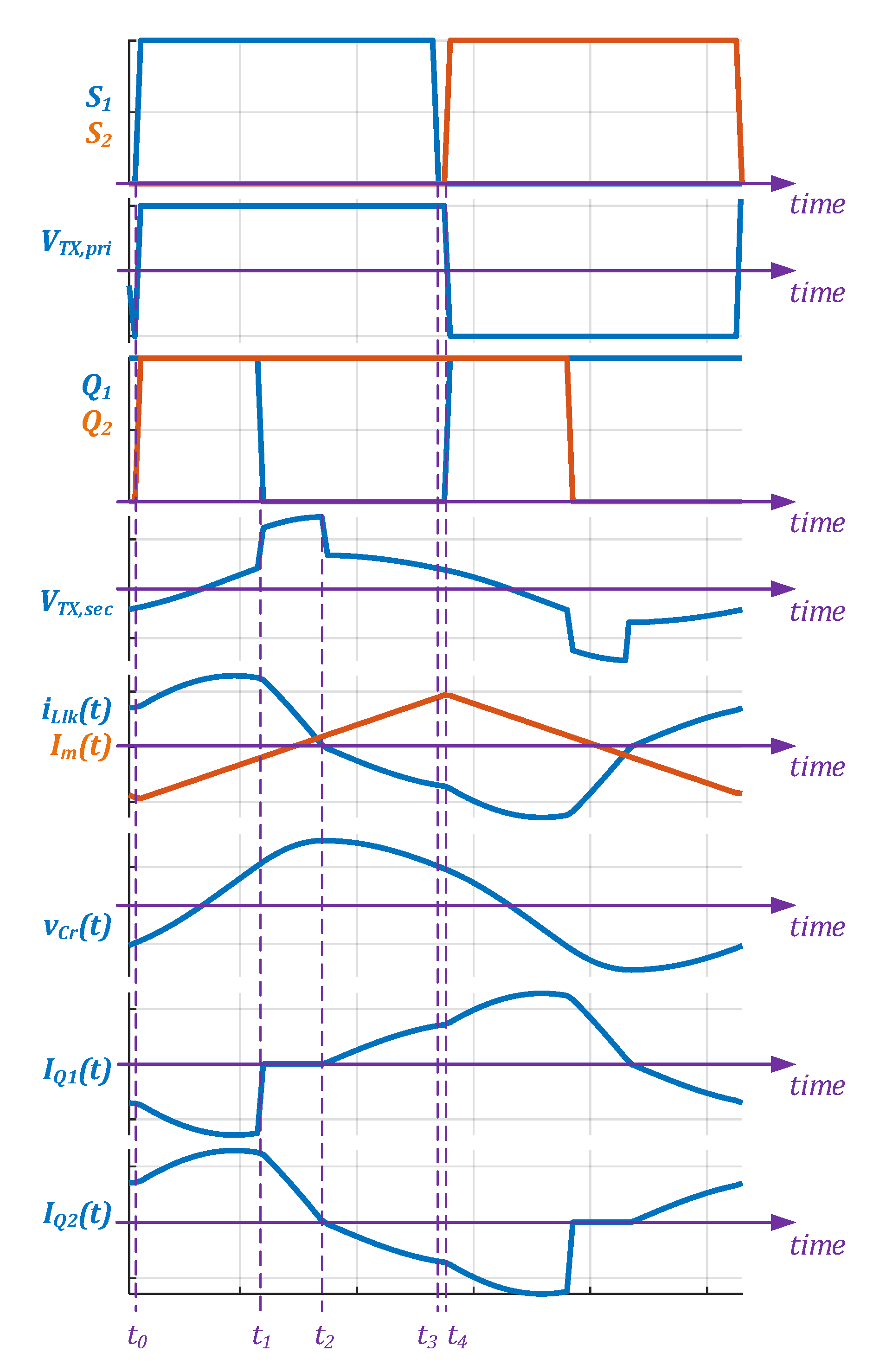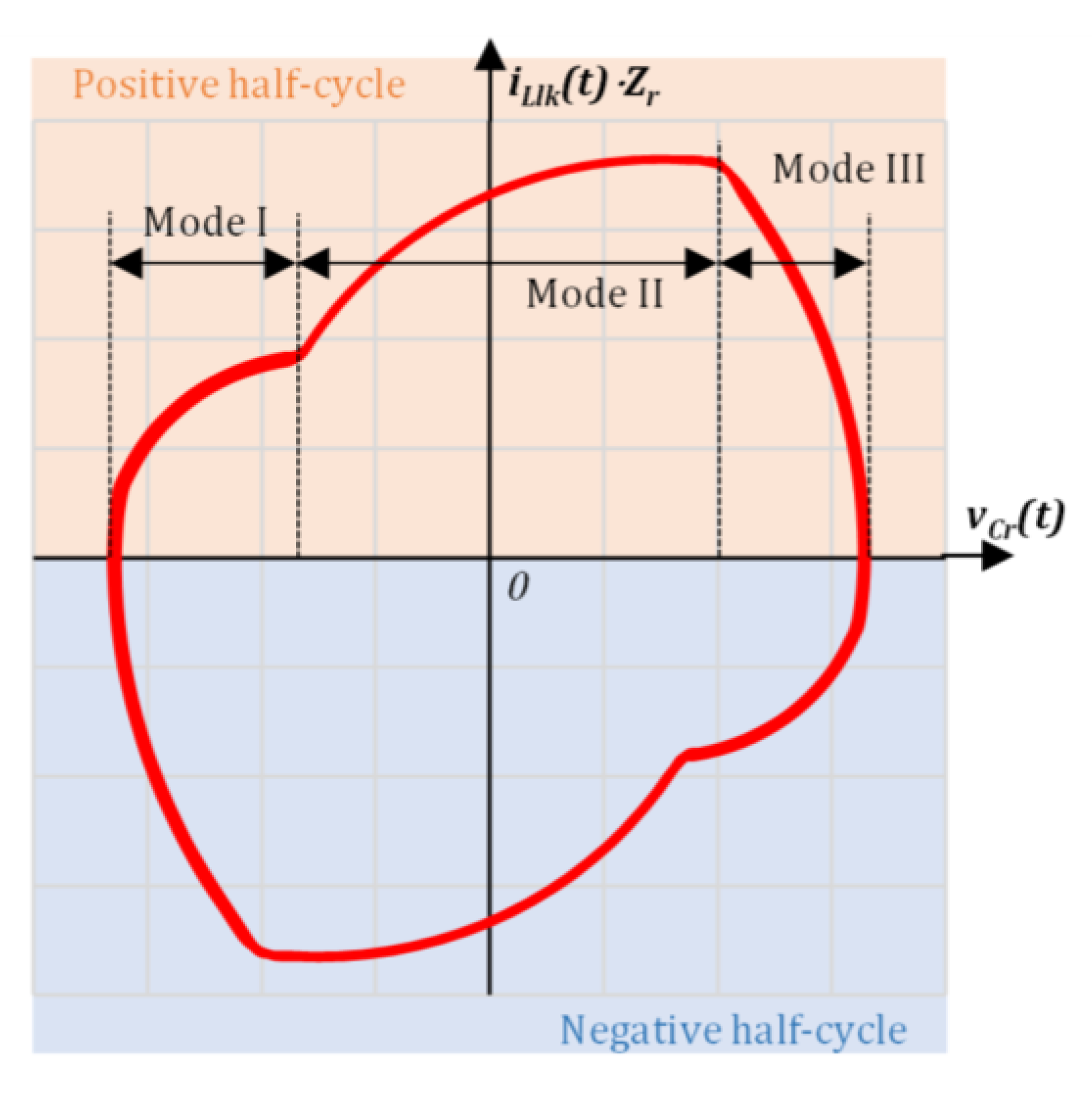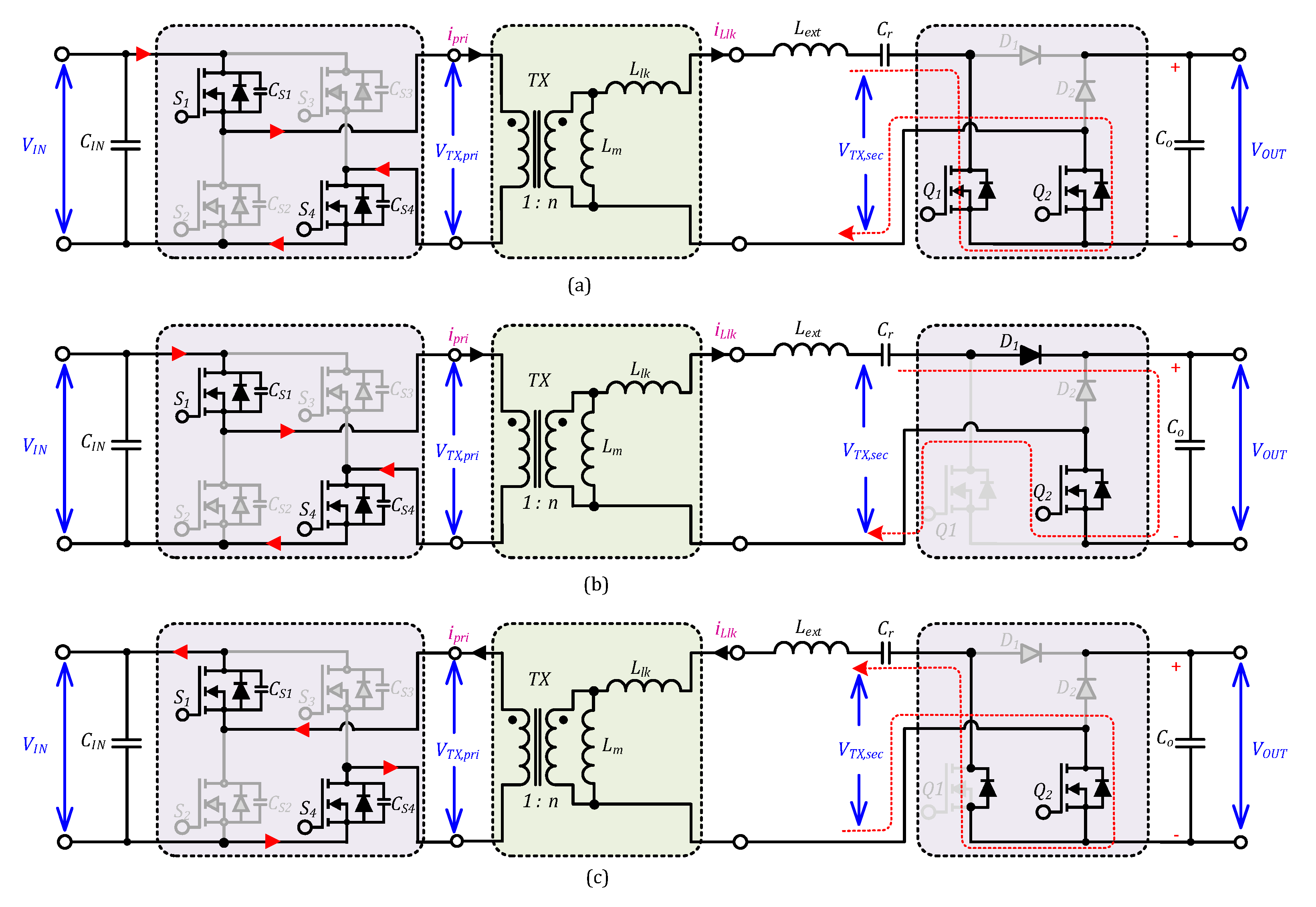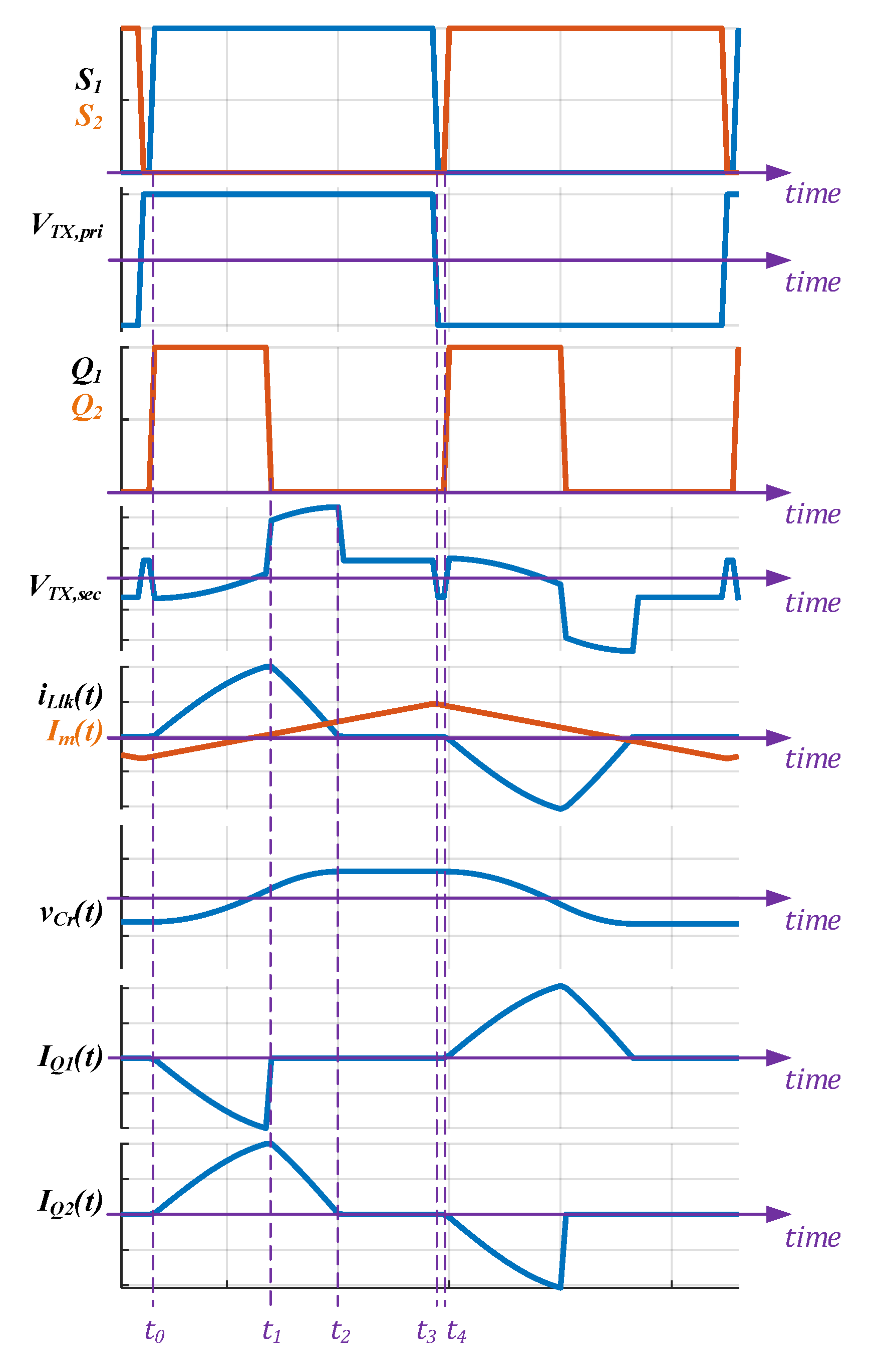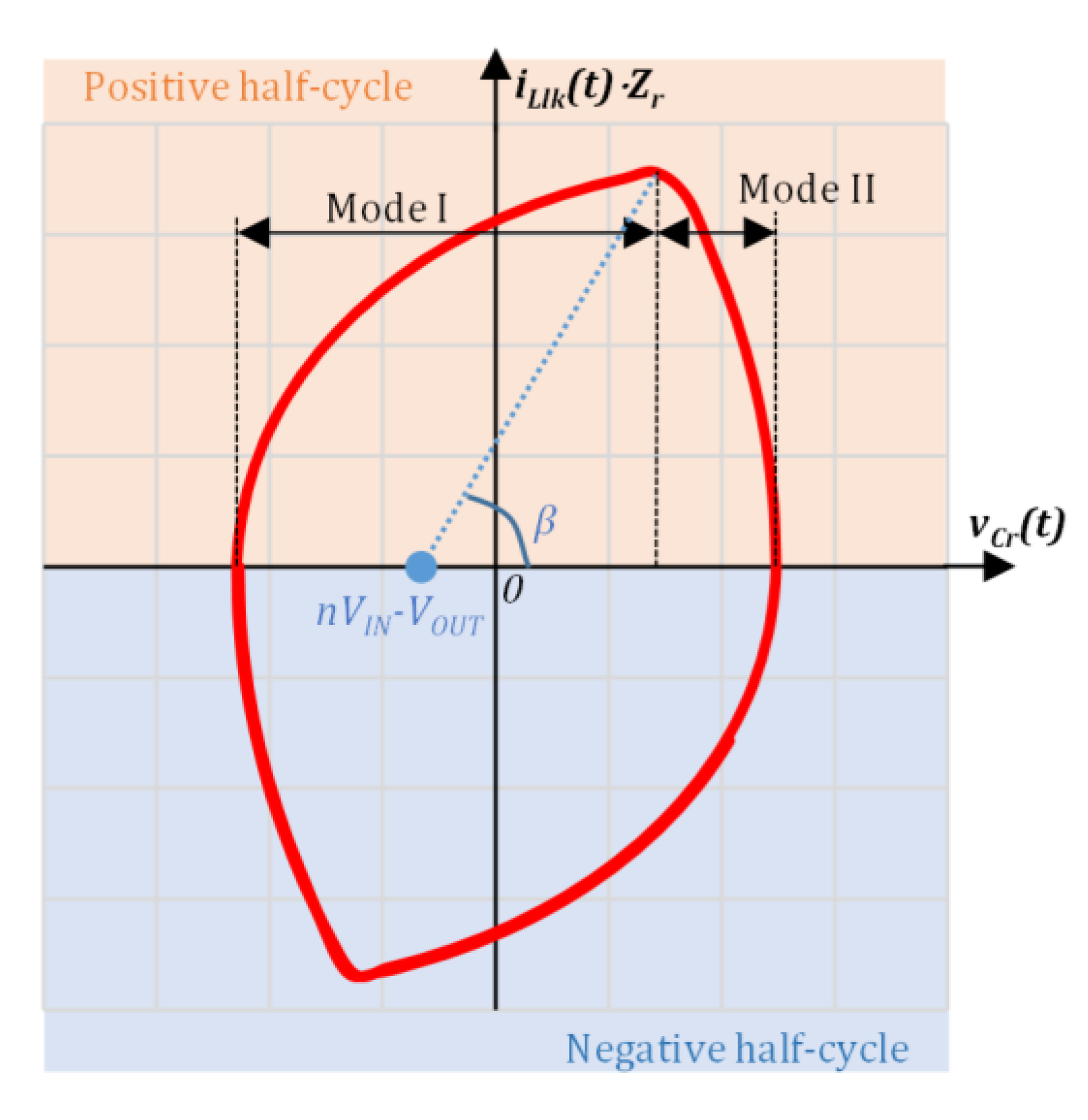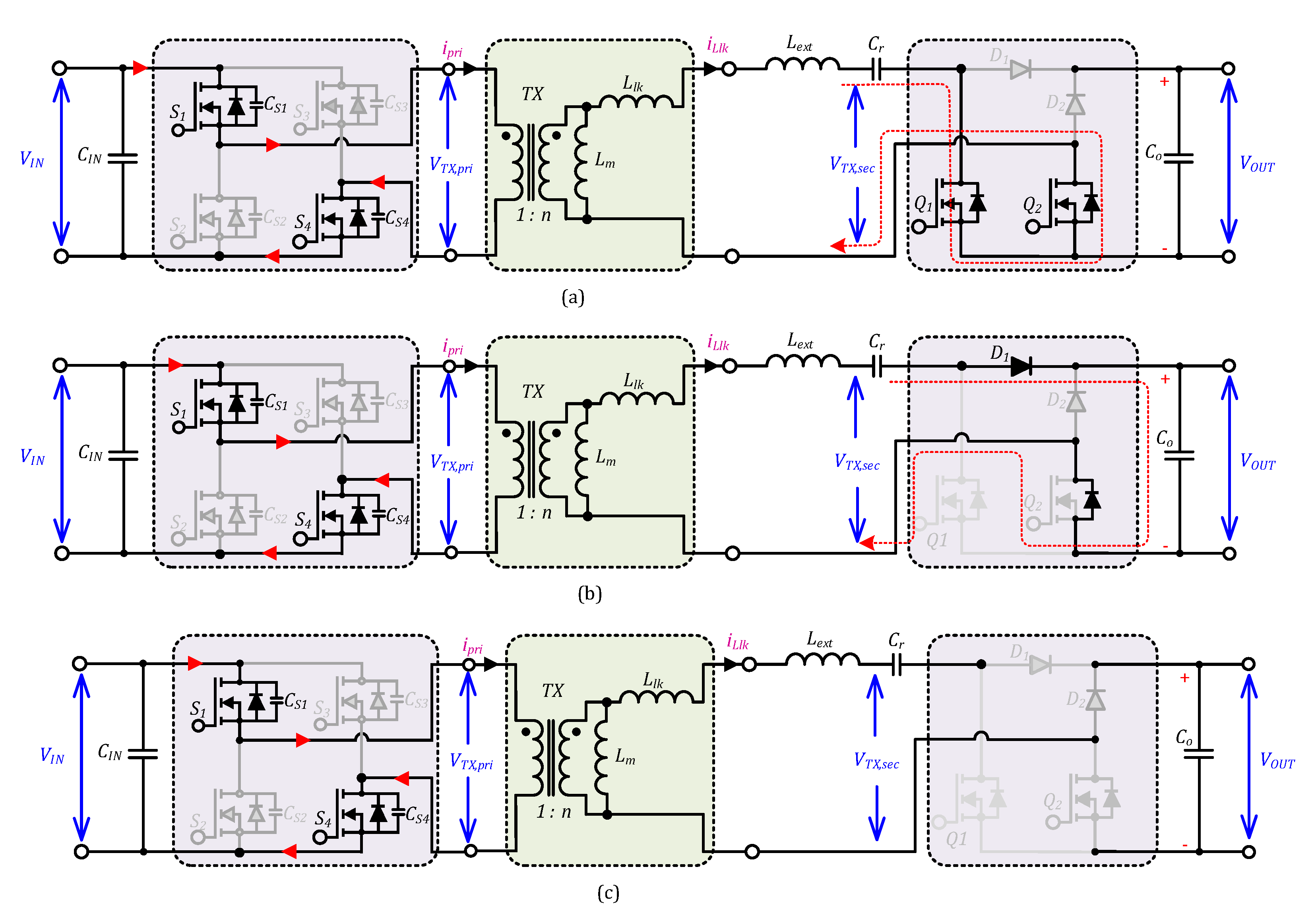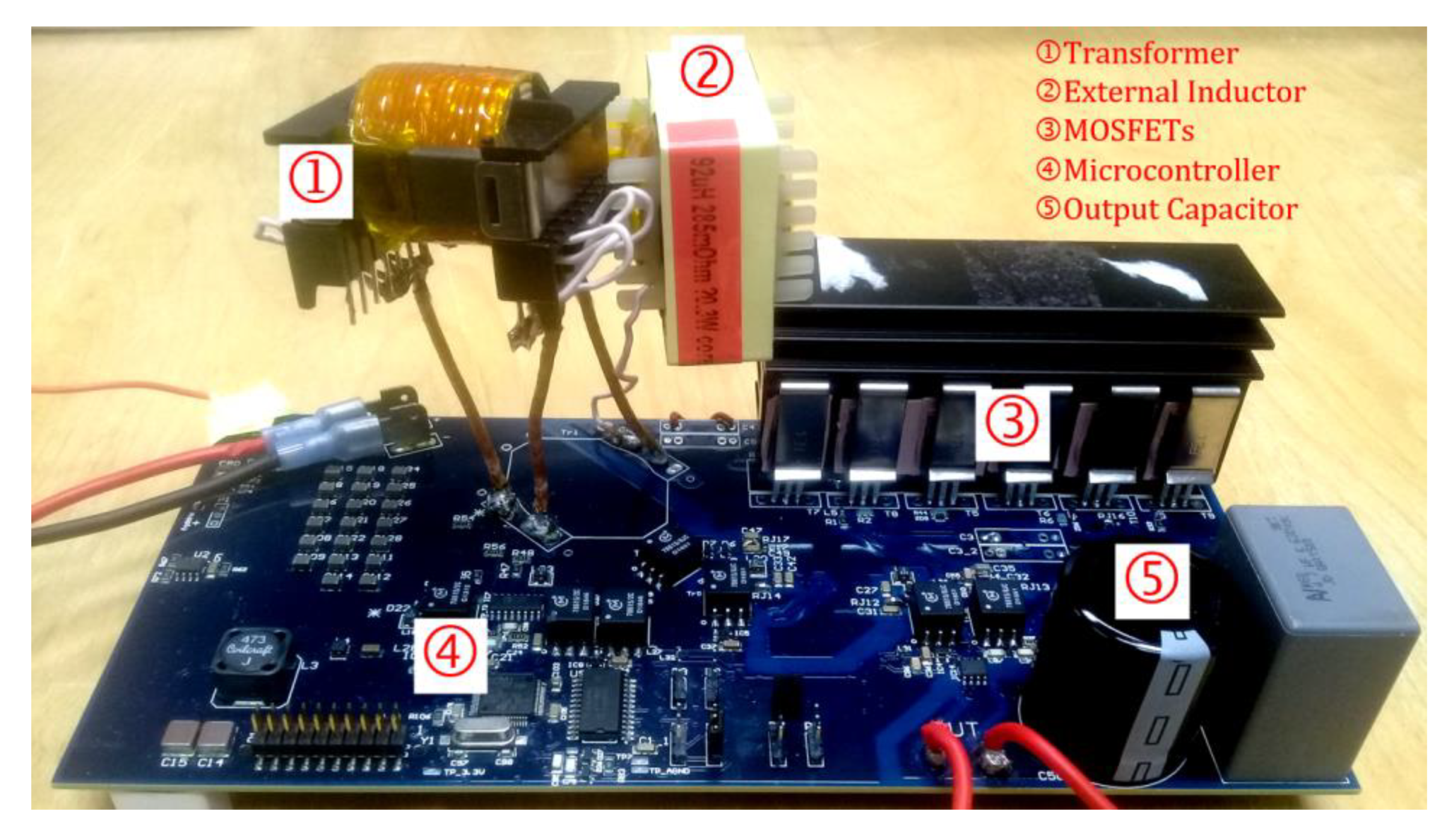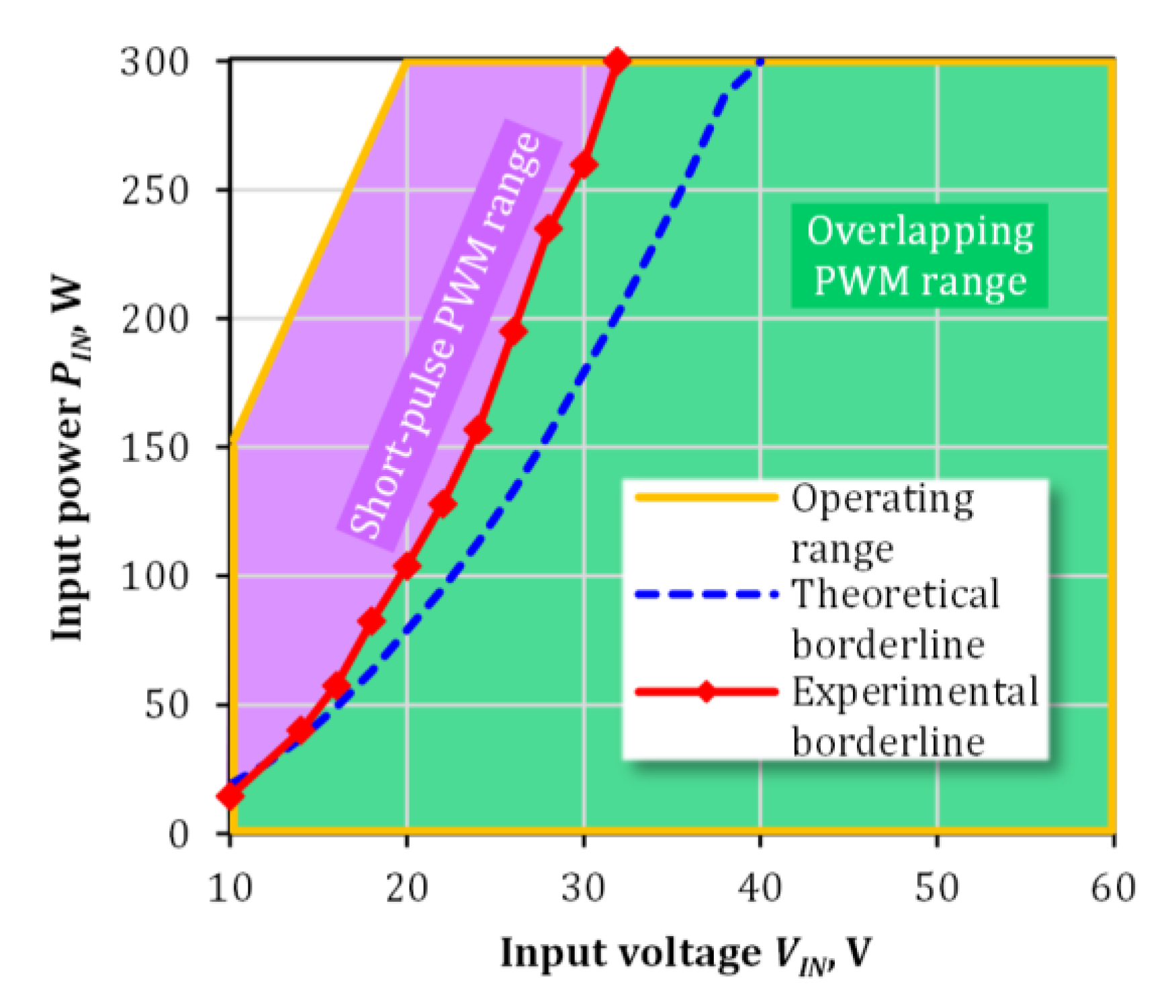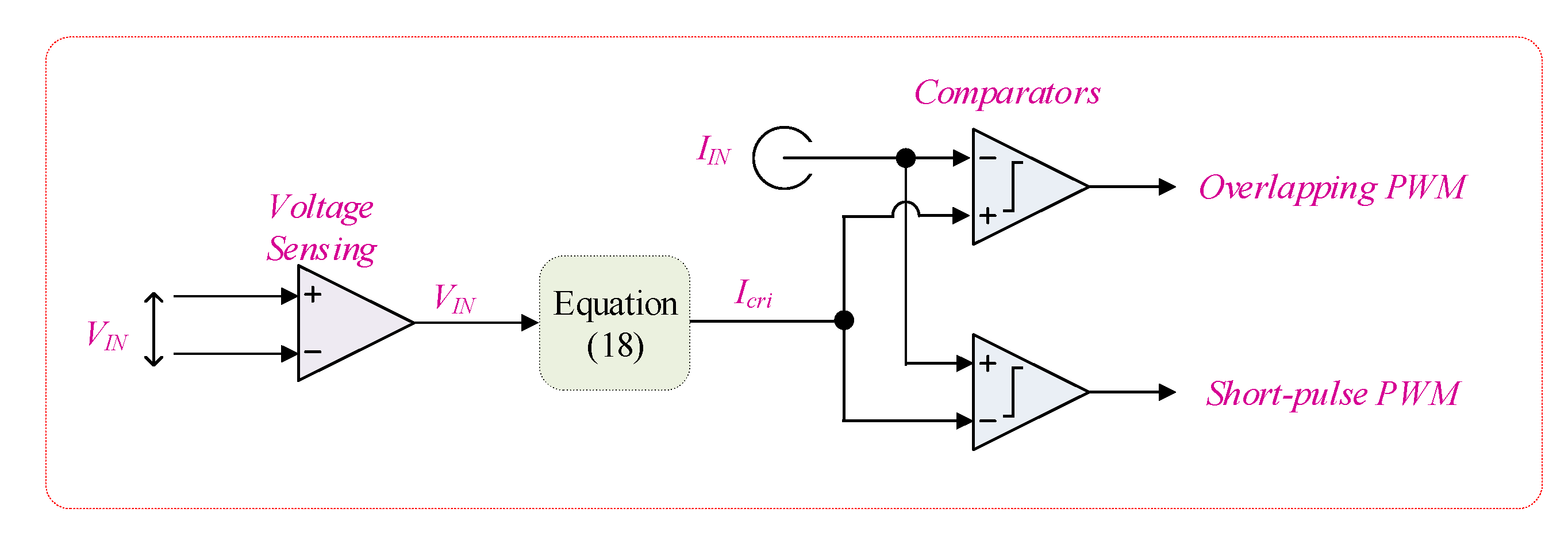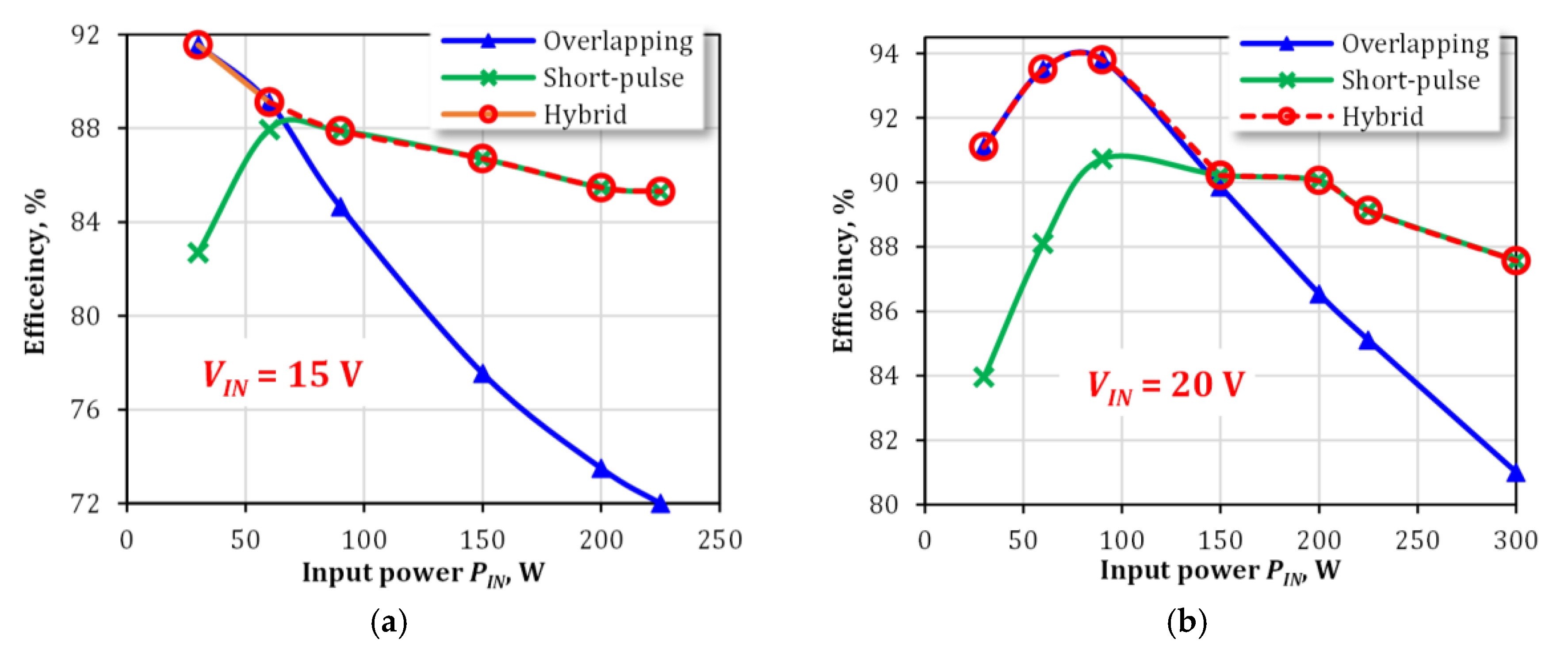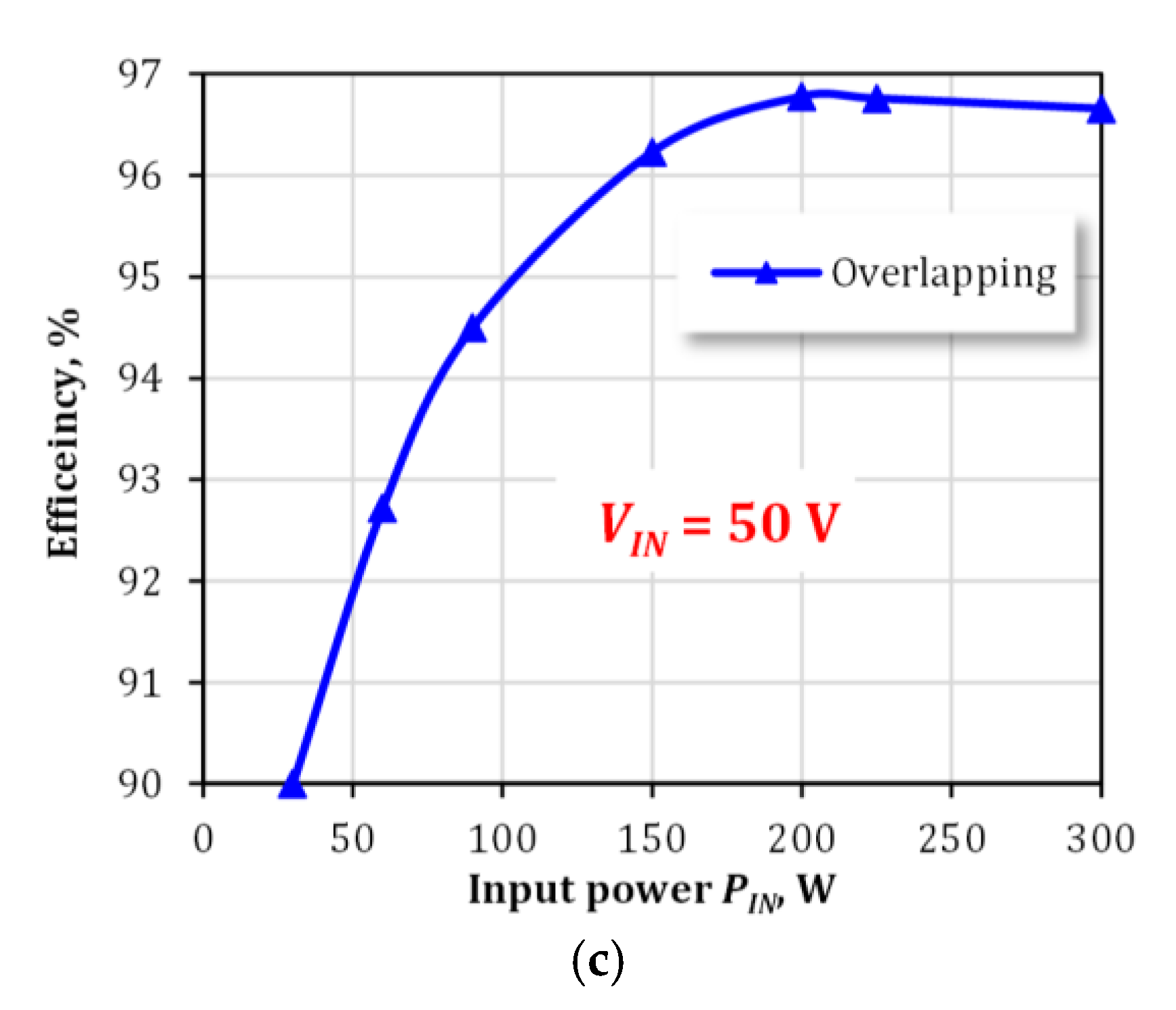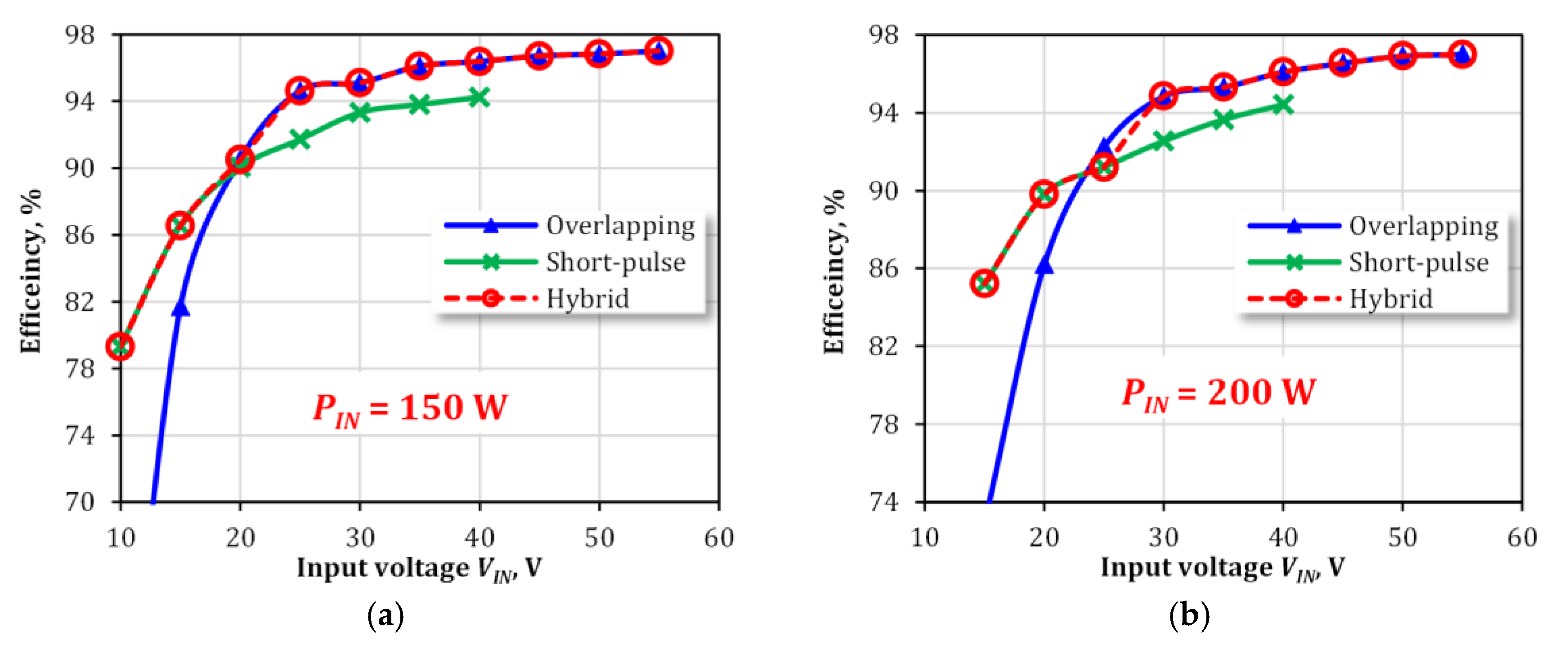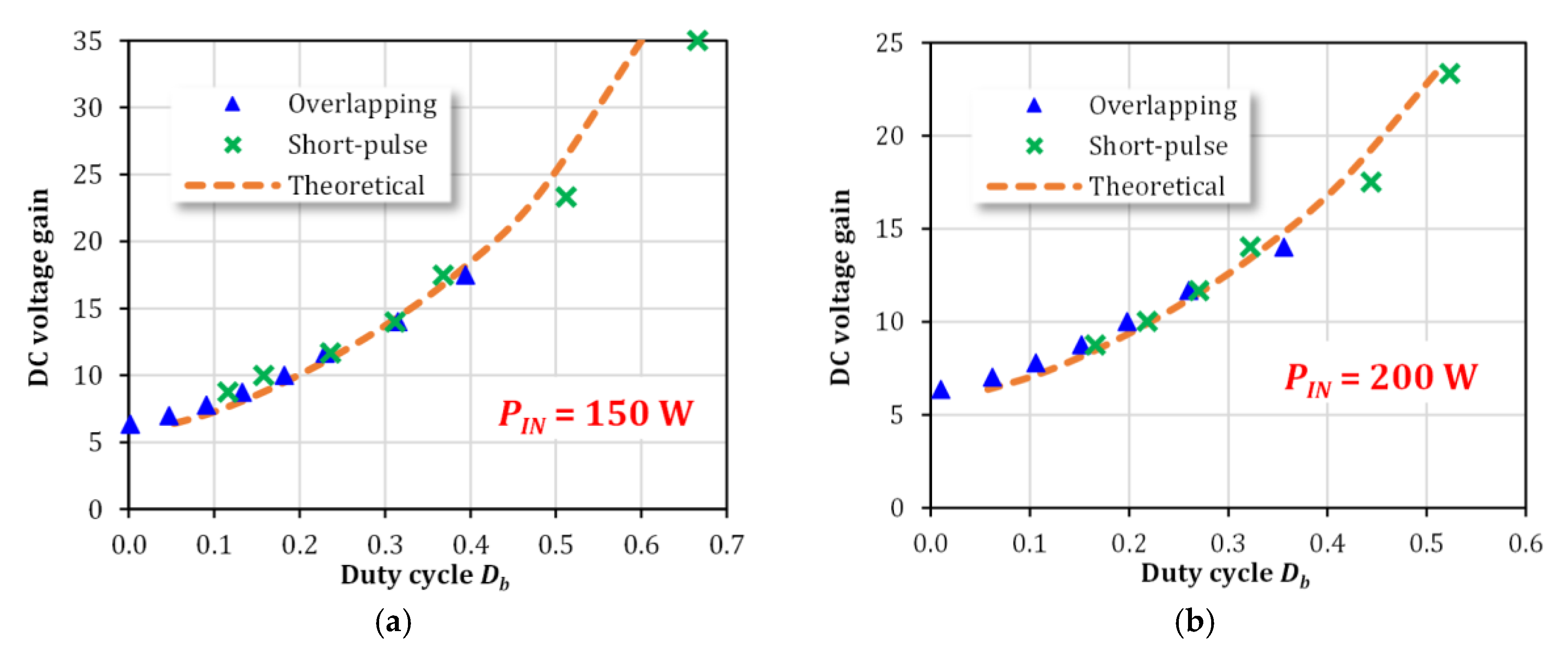1. Introduction
With the high growth of the cumulative installed power of the photovoltaic (PV) modules around the world, their cost is being reduced significantly [
1]. The reduction of their cost resulted in the emergence of new cost-sensitive PV applications in residential and small commercial sectors. New technologies, such as building-integrated or building-attached PV [
2,
3,
4], can achieve the best performance when combined with DC distribution [
5]. There, the galvanically isolated DC-DC converters are needed to interface individual PV modules into a DC bus. Such DC-DC converters should be capable of regulating the input voltage in a wide range of the possible PV module voltages [
6]. Also, the considered converters should provide high conversion efficiency in a wide range of input power as well as high power density [
7]. This could be realized either by the synthesis of new topologies or the development of new PWM schemes to enhance the existing topologies [
8].
The series resonant converter (SRC) is considered a promising solution for regulating the input voltage over a wide range. The SRC allows for transferring the power from the input to the load during the majority of the switching period, which improves the isolating transformer utilization. Also, it can achieve soft-switching operation when the switching frequency is selected close to the resonant frequency [
7,
8]. In the conventional SRC, the soft-switching conditions are fulfilled in the primary side semiconductors that are turned on a zero voltage switching. At the same time, the output-side diodes are turned off at zero current. Furthermore, the leakage inductance of the transformer is utilized as a part of the resonant tank, and thus the cost and size of the converter could be reduced as a result. On the other hand, conventional SRC usually employs the variable frequency control and thus provides only voltage step-down operation and suffers from poor controllability at low power. Therefore, the new approach based on the SRC was recently explored. It utilizes a resonant tank with the quality factor of much less than unity, and pulse-width modulation (PWM) to achieve input voltage buck-boost functionality.
Considering the buck-boost operation, the SRC has to be designed to achieve the best efficiency at the nominal input voltage in the vicinity of the most probable operating point of the converter. At the nominal voltage, the SRC performs neither voltage boost nor buck and thus achieves the highest efficiency where the full soft-switching of the semiconductors is guaranteed. When the input voltage has a higher value than the nominal voltage, the SRC can buck the input voltage by employing the phase shift PWM [
7,
9,
10]. Recently, many boosting cells have been evolved to address SRC operation at the input voltage below the nominal value, i.e., the boost operating mode of the SRC [
11,
12,
13,
14,
15,
16,
17]. In the boost mode, the SRC is designed to operate at a fixed switching frequency near its resonant frequency to ensure the highest efficiency. Also, the boosting cell is integrated into the secondary side of the isolating transformer to reduce the switching losses where the current is low in the high voltage side of the transformer. Moreover, the positive and negative half-cycles in these methods are symmetrical except in [
12], which has a single boosting interval within the switching period. In [
15], the synchronous rectification is used to avoid the conduction of the body diodes of the MOSFETs. Although this modulation method could improve the efficiency of the converter, the complexity and the cost of the system could be increased on the other side.
This study is focused on the SRC operation with the bridgeless boost rectifier proposed in [
11]. This case study was selected as it showed high overall performance and symmetrical operation of the transformer, which allow extending theoretical findings to other symmetrical boost rectifier topologies. This paper analyzes the operation of the case study topology in a wide range of the input voltage and power and demonstrates limitations not know before. The input voltage and current range limitations are associated with the operation modes of the resonant capacitor. When the voltage ripple of the resonant capacitors exceeds a certain critical value, the symmetrical overlapping modulation of the rectifier MOSFETs establishes a parasitic current path generating excessive power losses. The abnormal operating conditions could be avoided with a new modulation scheme where the rectifier MOSFETs are turned on only during the boosting time interval to avoid the resonant current flowing in the reverse direction. By exploiting the advantages of each PWM scheme in the best region of operation, the considered converter based on the SRC and the bridgeless boost rectifier can reserve the highest efficiency over all the input voltage range.
The remainder of the paper starts with
Section 2 that shows a previously unidentified abnormal operating mode of the case study SRC topology.
Section 3 introduces a new PWM scheme to be applied where the abnormal operating mode would otherwise appear and provides an analysis of the boundary condition to switch between the two overlapping and the proposed PWM schemes. The experimental verification results are discussed in
Section 4. Finally,
Section 5 concludes the paper.
2. Analysis SRC with the Bridgeless Rectifier Controlled with the Overlapping PWM
The bridgeless rectifier cell is commonly used in the applications of the power factor correction [
18,
19], and it has been implemented in the SRC to regulate the input voltage variations in [
11] for the converter shown in
Figure 1. The bridgeless rectifier cell has two switches (
Q1,
Q2) at the bottom of each leg and two diodes at the top (
D1,
D2). These switches are responsible for the implementation of the boost functionality in the converter. The control signals of the two MOSFETs of the bridgeless rectifier are overlapping during the boosting interval. This results in the short-circuiting of the transformer secondary winding connected in series with the resonant tank. As a result, the resonant inductor can act as an ac boost inductor and thus store energy supplied from the input voltage and the resonant capacitor. These switches (
Q1 and
Q2 in
Figure 1) implement the synchronous rectification in each half-cycle after the boosting interval ends, and the peak-to-peak voltage of the resonant capacitor depends on the converter operating point of the load power and input voltage. At some operating points, especially at the low input voltage, the instantaneous voltage of the resonant capacitor becomes larger than the equivalent voltage of the transformer secondary winding. In the normal operating conditions, the converter enters into the discontinuous conduction mode (free-wheeling state) when the resonant current drops to zero after a boosting time interval. On the other hand, the synchronous rectification resulting from the overlapping PWM scheme of the
Q1 and
Q2 along with the high voltage ripple of the resonant capacitor result in the resonant current flowing into the reverse direction after reaching zero value. The combination of these factors results in the abnormal operating mode of the SRC, which has not been described in the SRC previously. As a result, the conduction losses in the transformer would increase as the root mean square RMS current is high in the abnormal mode. Also, the semiconductor components of the converter are hard switching at a high current. Hence, the converter efficiency drops significantly at these abnormal operating conditions.
This section aims to describe the operating principle of the case study topology of SRC with the bridgeless rectifier in the abnormal operating conditions, and consequently, analyze the drawbacks of the overlapping PWM scheme. The input voltage
VIN feeds the primary winding of the isolating transformer
TX through the full-bridge inverter at the front-end side. Besides, the semiconductors in the same leg of the bridge are modulated complementary with a short dead-time in the boosting mode. The isolating transformer steps up the input voltage by the turns ratio
n and provides electrical isolation to increase the safety level of the circuit. The resonant tank consists of the resonant capacitor,
Cr, and the resonant inductor
Lr, which comprises the leakage inductance of the transformer
Llk, and an external inductance
Lext. This external inductor is usually exploited when the leakage inductance of the transformer is small to enhance the converter efficiency as the larger values of
Lr minimizes the RMS current in the circuit components [
16]. The resonant frequency
Fr is a function in the resonant tank parameters, according to Equation (1):
The two decoupled capacitors (
CIN and
CO) are harnessed to filter the input and output voltages, respectively. In this paper, the term
refers to the peak-to-peak ripple of the voltage across the resonant capacitor, which changes with the converter power
P, and the input voltage
VIN according to Equation (2). The circuit has been well-analyzed in the boosting case with the overlapping PWM scheme in [
11], but only for the normal operating condition when
. Therefore in this paper, the circuit will be analyzed only for the abnormal condition when
, as the operation of the circuit differs significantly from that described in [
11], and thus, the existing steady-state mathematical model is not valid. It is worth mentioning that the abnormal operating condition could happen only at a low input voltage and depends on the voltage ripple value of the resonant capacitor, as follows from Equation (2):
The steady-state waveforms of the converter are given in
Figure 2 for
. The dead-time is inserted between the control signal of the primary switches in the same leg to avoid the short-circuit across the input terminals. The magnetizing current
Im has a positive slope when the positive voltage is applied to the transformer windings and vice versa. The peak value of
Im does not depend on the load power; it is defined by the input voltage, the magnetizing inductance of the transformer
Lm, and the switching frequency
FSW:
The considered state variables are the resonant current
iLlk(t) and the resonant capacitor voltage
vCr(t). The state-plane trajectory of the resonant tank is sketched in
Figure 3.
The shape of the trajectory varies when the converter operating point changes. However, the positive and negative half-cycles of the converter operation are always symmetrical so that the circuit operation will be analyzed only for the positive half-cycle. In the abnormal condition, the state variables of the resonant tank are continuous and correspond to a piecewise-sinusoidal function in time during the whole switching period. The operation of the converter is analyzed, assuming the system is lossless and the output voltage is ripple-free as the capacitance CO is high. The four operating modes of the converter during the positive half-cycle can be given as below:
Mode I [
t0 < t ≤ t1]: This interval corresponds to a half of the boosting duty cycle of the converter. A corresponding equivalent circuit and a simplified equivalent circuit of the converter during this mode are given in
Figure 4a and
Figure 5a, respectively. Unlike in the normal operating conditions, the resonant current has an initial value of
I0 at the instant
t0. The primary winding of the isolating transformer is fed with a positive voltage by turning on the switches
S1 and
S4. The switch
Q2 will turn on at the high current of the resonant inductor while
Q1 is still conducting from the previous half-cycle. The voltage across the resonant capacitor has an initial value of
V0 at the instant
t0, which is larger than the value of
. Therefore, the resonant inductor current continues flowing in the same positive direction until the boosting interval ends.
Mode II [
t1 < t ≤ t2]: The equivalent and the simplified equivalent circuits are given in
Figure 4b and
Figure 5b, respectively. The switch
Q1 is turned off, and the diode
D1 is forward-biased by the resonant inductor current. Consequently, there is a direct connection to the load, and the energy stored in the resonant inductance is releasing to the load. This mode ends when the current drops to the zero value at the instant
t2, when the maximum value of the resonant capacitor voltage is achieved.
Mode III [
t2 < t ≤ t3]: This is considered the new operating mode of the converter, which was not described in [
11]. The equivalent circuit and the simplified equivalent circuit are given in
Figure 4c and
Figure 5c. The current of the inductor begins to flow in the negative direction through the parasitic current path created by the switch
Q1 and the body diode of the switch
Q2. The transformer voltage is still positive during this mode. The capacitor voltage has the maximum value that is larger than the equivalent secondary winding voltage. In this mode, there is no direct connection between the input source and the load.
Mode IV [t3 < t ≤ t4]: The dead-time between the switches is applied during this mode. The switches S1 and S4 are turned off. The inductor current is still flowing in the same direction until the next time-interval. Also, the resonant capacitor continues discharging its energy in the inductor. The primary current has a non zero value.
3. Proposed PWM Scheme for the Bridgeless SRC
It was shown in the previous section that the switches of the converter turn on at high current in the case of the abnormal operating conditions. Accordingly, this section is dedicated to the development of a new modulation scheme that avoids the parasitic current path and keeps the converter in the freewheeling state after the transformer current drops to zero. The main idea behind the proposed short-pulse PWM scheme is to turn on
Q1 and
Q2 only during the boosting interval at the beginning of each half-cycle. The steady-state waveform and state-plane trajectory for the proposed short-pulse PWM scheme are shown in
Figure 6 and
Figure 7, respectively. The switches
Q1 and
Q2 are switched on two times within the switching period, so their switching frequency is double that of the primary side switches. Despite this drawback of the proposed PWM scheme, the converter avoids parasitic circulating currents and thus could reduce the conduction losses significantly. Also, the turn-on losses of the switches
Q1 and
Q2 could be reduced compared to the overlapping modulation in the range of the abnormal operating conditions. Each switching half-cycle ends with a nearly zero resonant current, and consequently, the switches
Q1,
Q2 can turn on at zero current. Despite the use of a new PWM scheme, the voltage ripple ∆
VCr could be correctly described by the Equation (2).
The body diodes of the MOSFETs Q1, Q2 are employed as the rectifier diodes when the energy stored in the resonant inductor is discharged to the load. After all the stored energy in the resonant inductor is discharged, the resonant tank enters the discontinuous conduction mode, i.e., freewheeling state. Although the capacitor voltage is larger than the secondary voltage, no path is available to allow the resonant current flow in the reverse direction in each half-cycle. The average value of the resonant capacitor voltage equals zero with the proposed short-pulse PWM scheme.
3.1. Modes of Operation
There are three operating modes during each half-cycle of the switching period. The operation of the converter during the two-half cycles are symmetrical, so only the positive half-cycle is investigated in this paper:
Mode I [
t0 < t ≤ t1]: Before starting this mode, at the instant
t0, the initial value of
iLlk(
t) and
vCr(
t) equal zero and
, respectively. The corresponding configuration of the converter during this mode is given in
Figure 8a. The primary side switches
S1 and
S4 are turned on, and a positive voltage is applied to the primary winding of the transformer. This mode represents the half of the cumulative voltage boosting time interval, so the switches
Q1 and
Q2 are turned on as well. The resonant inductor begins to charge with a positive current until the end of this mode. The equations describing the state variables dependence on time during this mode could be defined as follows:
where
r1 refers to the radius of the state-plane trajectory arc with center at (
nVIN, 0), and
is the characteristic impedance of the resonant tank.
Mode II [
t1 < t ≤ t2]: The MOSFETs
Q1 and
Q2 are turned off, and the body diode of the switch
Q2 conducts the output current to transfer the energy stored in the resonant inductor to the load as shown in
Figure 8b. After the resonant inductor is discharged,
iLlk reaches zero; the converter enters the discontinuous conduction mode. Also, the diode
D1 and the body-diode of
Q2 are turned off at zero current, and thus, no turn-off power losses are dissipated. The capacitor voltage
vCr(
t) charges up to the maximum value of
. The state variables can be expressed for this mode as below:
where
r2 refers to the radius of the state-plane trajectory arc with the center at (
nVIN − VOUT, 0).
Mode III [
t2 < t ≤ t3]: This mode starts when the resonant current drops to zero at the end of the previous mode, and the converter configuration during this mode is shown in
Figure 8c. Consequently, the converter enters the discontinuous conduction mode (freewheeling state) and no energy is transferred to the load during this mode. The capacitor voltage remains constant at its maximum value at
until the end of this period at the instant
t3. All voltage and current values of the rectifier components remain constant during this mode, while the magnetizing current is increasing linearly, which influences the current of the input side switches.
Mode IV [t3 < t ≤ t4]: It represents the dead-time interval between the control signals of the switches S2 and S3, before the second half-cycle. The parasitic output capacitance of the switches S2 and S3 are discharging while those of S1 and S4 are charging by the magnetizing current. With the proper design of Lm and the dead-time values, the voltage of the parasitic capacitance of the switches can reach zero at the end of the dead-time interval. Consequently, these switches can be turned on at zero voltage in the next half-cycle.
3.2. Voltage Conversion Ratio
The cumulative duty cycle
Db represents the cumulative duration of the voltage boosting time intervals when the converter operates in the Mode I. The instant
t1 is the boundary between the Modes I and II. On the state-plane, the two arcs with radii
r1 and
r2 define the resonant tank trajectory during the positive half-cycle. They intersect at this time instant:
Based on Equation (4) and Equation (5), the resonant inductor current and resonant capacitor voltage at an instant (
t1) can be given as:
so, the value of the state-plane angle
that defines the starting position of the Mode II can be derived from Equation (7) and Equation (13) as:
Then, by using
, Equations (12)–(15), the cumulative duty-cycle of the converter can be defined as:
Nevertheless, the overlapping PWM scheme provides the lowest losses in the converter compared to the short-pulse scheme but only in the normal operating conditions. Therefore, the proposed hybrid PWM corresponds to using the overlapping modulation in the normal operating conditions and the proposed short-pulse PWM scheme in the abnormal operating conditions. This can keep the converter at a high level in a wide input voltage range.
5. Conclusions
The paper analyses operation of the series resonant DC-DC converter with the bridgeless boost rectifier in a wide input voltage range. It was shown that this converter experiences abnormal operating conditions at high DC voltage gain values, when the converter suffers from large circulating currents and, consequently, high power losses. This effect results from the use of the conventional overlapping PWM scheme in a wide input voltage range. To avoid the operation of the converter in the abnormal conditions, it was proposed to replace the conventional PWM scheme, where the duty cycle of the rectifier switches is over 0.5, with the short-pulse PWM scheme, where the duty cycle of the rectifier switches is reduced to the actual duration of the voltage boosting time intervals, where needed. In this way, the hybrid PWM scheme was introduced, which employes one of the two basic PWM schemes with the best efficiency at any operating point. The borderline between the two PWM schemes was defined experimentally and fitted with a second-order polynomial function, which enabled simple implementation of the closed-loop control system. Smooth transition between the two PWM schemes could be achieved as their boosting duty cycles follows the same theoretical law describing their dependence on the input voltage and power. This was verified experimentally when considering only normal operating conditions for the overlapping PWM scheme.
Hence, the logic defining the transition between the two PWM schemes was implemented with simple calculations and comparison operations, which could be decoupled from the main control loop. As a result, significant efficiency improvement of over 10% was achieved at low input voltages and relatively high input currents, where the short-pulse PWM scheme is employed. The peak converter efficiency of 97.1% was recorded near the minimum DC voltage gain. The converter demonstrated a nearly sixfold range of the DC voltage gain experimentally, which is a remarkable result considering that only the input voltage boost operation was considered. Future research will be focused on optimization of the converter components for operation in a wide input voltage and current range to improve the converter peak and average efficiency.

